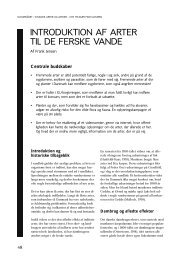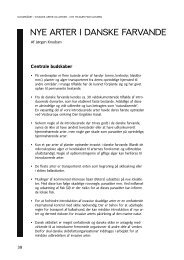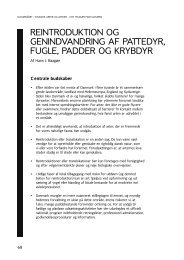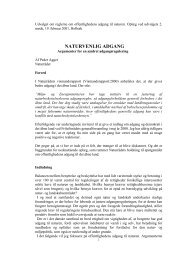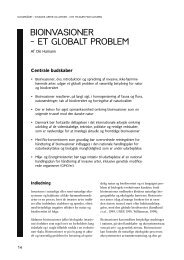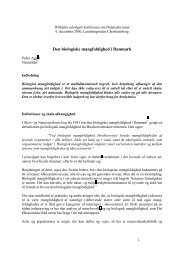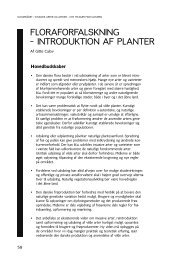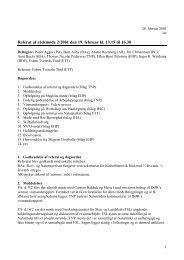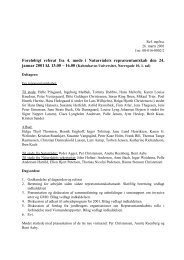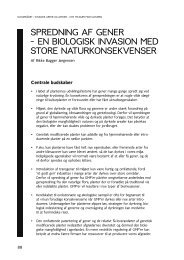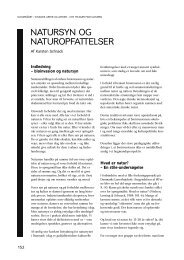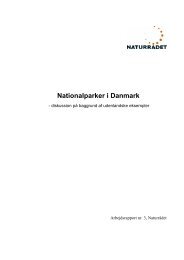Læs hele rapporten som pdf-fil. - Naturrådet
Læs hele rapporten som pdf-fil. - Naturrådet
Læs hele rapporten som pdf-fil. - Naturrådet
You also want an ePaper? Increase the reach of your titles
YUMPU automatically turns print PDFs into web optimized ePapers that Google loves.
NATURRÅDET / TEMARAPPORT / NATUR OG LANDBRUG<br />
70<br />
Landscapes and biodiversity<br />
Historically, agriculture created a patchwork of<br />
habitats that is richer in biodiv e r s i ty than the original<br />
natural landscape in Europe. Over centuries<br />
the number of plant species increased as the natural<br />
mixed deciduous woodland landscapes were<br />
opened up and became more diverse through<br />
human intervention. In recent decades, how e v e r ,<br />
agricultural land use has become more and more<br />
intensive and is now one of the main causes for<br />
an increasingly rapid extinction of plant and animal<br />
species. In many parts of Europe more than<br />
a third, in <strong>som</strong>e areas even over half of all know n<br />
species are either already extinct or at serious risk<br />
(ECNC 1999). This dramatic loss in Eu r o p e a n<br />
biodiversity is due to the elimination of and the<br />
i n t e r ference with not only natural, but also with<br />
semi-natural habitats and biotopes, many of which<br />
have been in agricultural use for centuries.<br />
Agricultural structural changes resulted both in a<br />
loss of sites and structural elements of the<br />
European countryside, as well as in changes in the<br />
water and nutrient regime of its ecosy s t e m s .<br />
Traditional, low-input farming systems, on which<br />
many wild plant and animal communities are<br />
crucially depended, are often no longer economically<br />
viable and have been abandoned. In<br />
Germany, almost 700 of the approximately 2700<br />
vascular plant species have to be considered threatened.<br />
Agriculture has been involved in more<br />
than 500 cases where the causes for decline have<br />
been identified. On the other hand, nature cons<br />
e r vation cannot succeed without fa r m i n g<br />
( Bundesamt für Naturschutz 1996). For exa m p l e ,<br />
studies have shown that more than 80% of the<br />
rare and declining bird species in Europe rely<br />
on agricultural land, in particular extensiv e l y<br />
managed grasslands (Figure 4).<br />
Visible and invisible changes<br />
Agriculture has been responsible for a variety of<br />
c h a n ges, which have contributed to species<br />
decline. There are obvious changes in the landscape<br />
in areas where hedges have been removed<br />
or where drainage has taken place, or where<br />
land consolidation has created a more uniform<br />
farming landscape. Also changes in traditional<br />
farming systems, like wood pastures in the Spanish<br />
dehesas, or the replacement of old olive groves<br />
and orchards by modern plantations, have an<br />
enormous influence on species div e r s i ty (Ba l d o c k<br />
1990, v. Meyer 1993). These are examples of<br />
the more visible changes, but probably much<br />
more significant are the invisible changes such as<br />
pollution or eutrophication of habitats and biotopes.<br />
Such processes cannot be perceived directly,<br />
but they fundamentally alter the nutrient conditions<br />
and ecological balances of large areas. Most<br />
European plant species are associated with nitrogen-poor<br />
environments. However, the trend in<br />
agricultural farming systems has been towards<br />
intensification, thus increasing the nutrient input<br />
to those habitats. The result is that threatened species<br />
are mostly those that depend on low - n u t r i e n t<br />
biotopes, and this is true for various kinds of<br />
habitats (Ellenberg 1989).<br />
Eutrophication of arable land<br />
Eutrophication is clearly one of the main causes<br />
for species decline. In the EU Member States,<br />
since 1950 average application rates of mineral<br />
nitrogen fertilizer increased fourfold from less<br />
than 25 kilogrammes of nitrogen per hectare<br />
(kgN/ha) to over 100 kgN/ha today. These figures,<br />
however, relate only to the average national<br />
application rate of mineral fertiliser. What matters,<br />
however, is total nutrient input, including in<br />
particular animal manure, and the surplus of<br />
regional nitrogen balances. German studies show<br />
that for the whole of West Germany the total<br />
n i t r o gen input from mineral fertilizer and animal<br />
manure increased from about 25 kgN/ha to<br />
more than 150 kgN/ha since 1950. Over the<br />
same period nitrogen withdrawal through harvested<br />
crops increased only from about 20<br />
kgN/ha to 40 kgN/ha. This means that the nitrogen<br />
surplus emitted annually from the agricultural<br />
system increased twenty-twofold from 5 to 110<br />
kgN/ha (Köster & Severin 1988). Similar figures<br />
have been calculated for other countries, and<br />
regional “hot spots” show even much higher surpluses.



